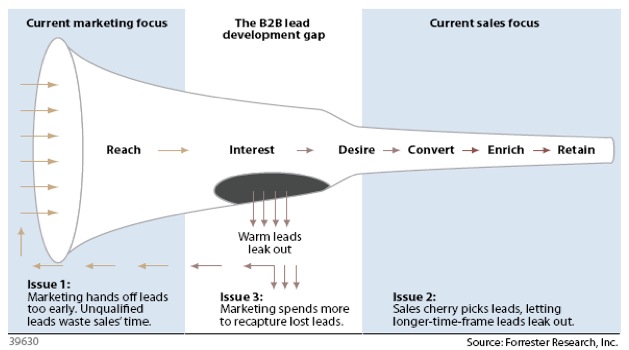“Most companies really don’t have any idea of where they are today in the area of lead management, especially as it relates to a lead management framework,” Hidalgo said. “You have to work at it and in order for it to stick you have to understand this about change management and is a long-term proposition.” Hidalgo advises organizations to begin by getting an understanding of where they are today in their organizations. As this review is completed and companies see where the gaps exist, they can then review what changes must be made to build and maintain an effective process.
Hidalgo pointed out that the common lead management approach, where Marketing hands off leads to Sales too early, can cause Marketing teams to spend more time recapturing lost leads, while Sales teams spend too much time cherry-picking leads. This can result in leads with longer buying cycles, potential warm leads leaking out of the funnel, and an overall poor quality of leads being handed off to Sales. The approach requires increased effort on behalf of both teams, but ultimately is not an efficient way to maximize leads and is often the cause of alignment issues that are all to common.
The Annuitas Group’s blueprint for effective lead management consists of the following seven process areas:
- Data Management – Determining the validity of your database
- Lead Planning – The traditional, linear-based funnel can devalue potential ROI
- Lead Routing – Determining how Marketing will pass qualified leads to Sales, how leads will be passed onto nurturing campaigns and how Sales will pass leads back to marketing
- Lead Qualification – Defining every step in the buyer journey, assigning attributes to those definitions and then building a lead score model
- Lead Nurturing/Scoring – Building a relationship with prospects and nurturing for pipeline acceleration;
- Content – Developing of content and offer maps along the buyer’s journey
- Metrics – Developing benchmarks and KPIs for your organization to measure against quarterly.
Hidalgo emphasized the interdependencies in each of the seven areas of lead management. He recalled conversations with his own customers about how some want to approach one area rather than all cohesively. “Marketers that focus solely on lead scoring still have to address the issues around qualification, routing and planning”, he said. “To maximize the success of the Framework, it must be approach holistically and completely.”
As organizations strive to target and segment prospects and leads to optimize marketing efforts, Hidalgo said it’s imperative “to ensure the cleanliness and timeliness of data.” He noted, “data is constantly changing, and organizations must keep pace by making it a top priority.”
“Data should be a tremendous focus for organizations,” he said. “I don’t care how relevant your message is, how mature your process is, how or slick your automation and CRM systems are. If you don’t have anyone to reach or speak to, it doesn’t matter. I’m continually confounded at the amount of negligence that organizations are showing towards their data.”
Hidalgo noted that data is a “paramount” key process in the framework, and requires consistent management for optimal results. “Data is like content; you have to constantly update it,” he said. “Data goes bad quickly so develop that hygiene process and then put in place business rules that establish the right controls for that data.”
All seven components of the Lead Management Framework are reliant upon a cohesive strategy, he added, through which Sales and Marketing teams work more cohesively to define objectives and goals for lead planning, as well as revenue. By honing in on a specific revenue goal, Marketing teams will be better equipped knowing how many leads must be generated to help Sales achieve quota.
“Metrics act as the dashboard that allows you to determine if you’re doing things well and right,” Hidalgo said. “Fifty-two (52%) of organizations are measuring the wrong thing, or don’t know what to do with their measurements.” Hidalgo said organizations must efficiently leverage Business Intelligence (BI) metrics and apply them to strategies from a Sales & Marketing perspective.







